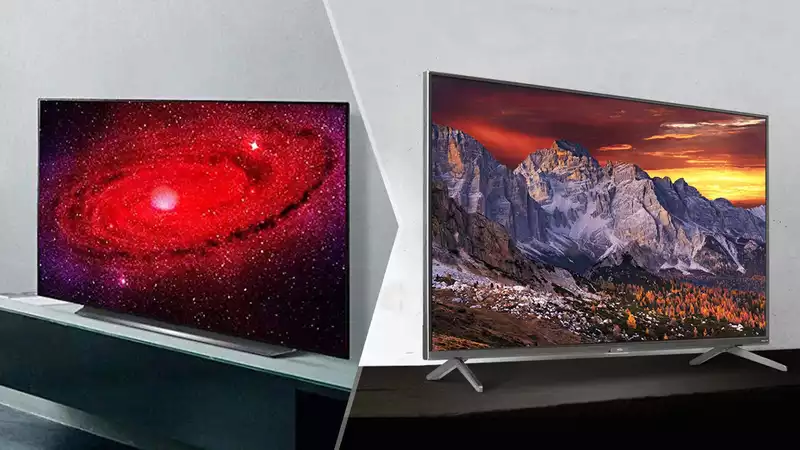Over the past few years, OLED TVs have dominated the large-screen market with images and colors so sharp that they are unmatched by any other display technology. Quantum dot-based LCD sets have also come close with 4K images, but OLEDs have continued to reign supreme.
That is about to end, as TCL is the first TV manufacturer to announce a competing LCD-based display using mini-LED technology. It is designed to compete with LG's OLED displays at a much lower price point. So will it succeed? We decided to do a screen-to-screen comparison between the LG CX OLED and the TCL 6 series Roku TV (R635) to find out.
The LG CX OLED has a handful of screen sizes ranging from 48" to 77", but for most shoppers, the 55" and 65" options will be most attractive. The TCL 6 Series, on the other hand, comes in three sizes: 55, 65, and 75 inches.
Comparing the two model lines, the LG CX OLED 48-inch model is a great option for smaller rooms that cannot accommodate more than 55 inches and is also an excellent gaming TV.
The biggest difference, however, is price, with the TCL 6 series priced much lower than LG's premium OLED models. In fact, LG's pricing picks up right where TCL left off, with the most affordable being the 48-inch model, which is $100 more than the most expensive 75-inch TCL 6 Series model.
If you are looking for the most affordable option, TCL is an easy choice and our top recommendation for value shoppers. However, the LG CX OLED offers premium performance and features that the TCL cannot match.
Most LCD TVs use LEDs for the backlight that illuminates the screen. Some have LEDs along the edges, while others use so-called full-array LED backlighting with diodes placed at strategic locations behind the LCD layer. The mini-LED design improves on this system by using small (less than 0.2 mm) and numerous LEDs for the backlight, creating more zones and allowing for improved image contrast and highlights.
(Mini LED sets should not be confused with micro-LED technology, which assigns even smaller LEDs to individual pixels. Such sets have millions of LEDs and cost thousands of dollars.)
LG's OLED (organic light-emitting diode) TVs are crisp and sharp because there is no separate backlight. The organic pixels emit their own light when activated. This allows each pixel to be turned on and off completely individually, resulting in blacks that are darker and hues that are deeper.
To increase color reproduction capability, TCL's 6 series sets use quantum dot layers to reproduce more colors than standard LCDs. For example, they are better at reproducing richer, deeper greens and reds, and in our tests were able to reproduce 99.92% of the standard Rec 709 color space. This is at the same level as other quantum dot sets, which tend to exceed 99%; in color accuracy tests using an X-Rite colorimeter and CalMan software, the 55" TCL 6 series showed a Delta-E rating of 2.8 (the closer to 0 the better).
However, OLEDs are still the kings of color, and the 65-inch LG CX delivered the widest color gamut we have ever tested, reproducing 134.57 percent of the Rec 709 color space for head-and-shoulders image intensity. It also achieved excellent color accuracy with a Delta-E score of 1.95.
However, image quality is not just about color. There are also practical issues related to brightness and viewing angle. In a sunny room, TCL's 6 series would be the best choice. In general, LCDs are better at increasing light output than OLEDs overall.
But this may all depend on where you are sitting on the couch; LG's OLEDs maintain color and clarity at nearly every viewing angle, even if you are the last person on the couch. And while mini-LEDs have served TCL's 6 series models well, their displays are not as good as OLEDs.
Winner: LG CX OLED
If you're looking for a big screen for big games, both sets have attractive features; the TCL 6 Series is the first model to boast THX-certified gaming modes. Not only does it improve response times, but it also meets requirements for color quality and handling transitions from dark to bright. They also support ALLM (Auto-Low Latency Mode), which automatically switches to game mode, and VRR (Variable Refresh Rate), which eliminates picture judder.
These are nice features, but in our response time tests, the TCL 6 Series was acceptable but not impressive. The overall delay time was 21.5 ms. In comparison, the LG CX OLED's response time of 13.1 milliseconds was outstandingly fast, making it the winner here.
Winner: LG CX OLED
Most smart TVs from major manufacturers have more than enough software to handle streaming services and apps. LG uses its own webOS software with easy-to-understand graphics, all major streaming services from Hulu to Showtime, and a remote control that uses a convenient floating screen cursor. set, but it does not offer hundreds of streaming apps, but there was one glaring omission.
LG's CX also supports Google Assistant and Amazon's Alexa. Additionally, the remote's microphone can be used to adjust the voice based on seat position.
By comparison, TCL's 6 series uses the simplest yet most widely supported smart TV software, Roku TV, which boasts thousands of apps and the most straightforward video-oriented interface; Roku will also follow voice commands, but does not have the capabilities of Alexa or Google Assistant. Instead, it focuses on finding the programs you want quickly.
Winner: tie
If you want the best 4K picture, LG's CX OLED remains the clear winner, regardless of cost. However, mini-LED technology shows that LCDs continue to improve. That makes the TCL 6 Series a value that should not be ignored: the 55-inch TCL 6 Series costs just $649.99, compared to $1,399.99, nearly double the price of the LG CX. For many savings-minded shoppers, this is an irresistible deal.
.









Comments